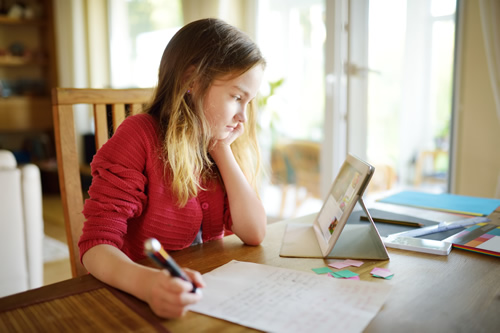Students submit work, teachers grade work, we move on. Sound like what happens in classrooms? Mine neither. However, when we transitioned to remote learning I found myself falling into this cycle. The consequences were obvious immediately–student work deteriorated.
I quickly had to figure out–how could I incorporate the feedback cycle that was so effective in my classroom but online?
I made a few tweaks to ensure students were engaging with that feedback that I think you can learn from:
1. Find a way to see student work during class time
In my classroom, I use EdLight to collect images of student work in the moment. Students submit photos of their work using their Chromebooks towards the end of class. I prefer collecting work during class because I’m more likely to get students to submit than if I asked for them to submit it asynchronously. I think it’s so important to have a point in class where students show me their work so they are held accountable for the standard.
For math this is especially important because I can see where they made their mistake. Some students even have time at the end of class to resubmit their work after making a correction that I suggested. Students are much more engaged when we do synchronous work submission.
Here is an example of how I can see handwritten student work during class time:
2. Give feedback to the whole class
Once I have the student work I find it far more effective to give feedback to the whole class, so I do my best to scan student work after they submit it before I dismiss my class. I skim to see if there are any mistakes that my students have in common that I can help them fix in their work. I often pull up a piece of student work collected from EdLight to show my class how to fix it.
This is easier to do in the moment than if I waited until the next day, and students can work together to fix the mistake in the work. For younger students unable to read your comments, your feedback can’t be spoken aloud or typed,
so giving feedback aloud in the moment can help with this barrier. It can build great community in a class to work on feedback together and see they aren’t alone in the mistakes they make.
Here is an example of how I can monitor student work using EdLight during class:
3. Monitor for a specific problem or task
Looking at student work during class can feel very overwhelming for a teacher to monitor so many things at once. I make this easier for myself by only looking for one specific task, problem or area of mastery to give feedback on each day.
I try to pick the most important thing students need to understand and only skim their work for that. I’m able to give much better feedback to students when I know what I’m looking for. If you give too much feedback, students will feel overwhelmed and not grasp it/know what to prioritize, so narrowing your focus can really help everyone. If you talk about student work in the moment, it also saves you time later where you might have to find students to work with
them individually on fixing their work.
Here you can see I filtered to only look at Task 2 and can give feedback to multiple students at once quickly:
Giving feedback to students is useless if we aren’t looking at it during the lesson, so I encourage you to make these tweaks to collect synchronous photos of student work. Students will feel more engaged and you will see improvement in their work if you focus on these changes in your instruction.
- DEI in education: Pros and cons - December 24, 2025
- Edtech teaching strategies that support sustainability - December 23, 2025
- Grading student work with AI: What we lose when AI replaces teachers - December 22, 2025




